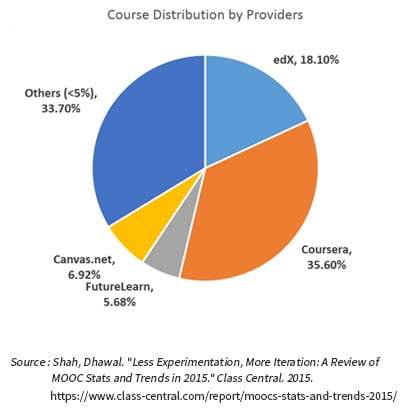
If you have been involved in Learning and Development for any length of time, you know how important it is to create a learning organization where people are eager to improve themselves and their workplace. You may also be aware that Massive Open Online Courses (MOOCs) in your learning strategy could help you do that.
We admit we were skeptical. About ten years ago we explored Open University courses and didn’t find much of interest. We found the learning mode to be inappropriate for busy people who didn’t want to sit through long recorded lectures. For programming courses, a well-designed book and a programming tool worked much better.
Academia’s Response to Competition
Much has changed since then. People seeking employable skill sets are avoiding the high cost of college by focusing on skills training. Non-academic providers like Udemy deliver hundreds of low-cost or no-cost expert courses.
In response, universities are deploying courses in multiple learning modes. They are creating hundreds of certificate programs and project-based skill training courses, and have adopted self-paced learning. Accredited management and leadership courses online have become mainstream.
MOOCs are growing rapidly. Class Central reported in 2015 there are more than 4,200 courses available from 550 universities, and 35 million people have enrolled in courses. The number of courses available nearly doubled in 2015.

 The number of providers is growing, and most of them have found viable business models. Many are “freemium” providers, meaning they provide most content free but charge a fee for premium courses and certificates. Class Central has a list of 37 providers of free content. Elearning Industry has a list of nine providers that directly supports corporate learning.
The number of providers is growing, and most of them have found viable business models. Many are “freemium” providers, meaning they provide most content free but charge a fee for premium courses and certificates. Class Central has a list of 37 providers of free content. Elearning Industry has a list of nine providers that directly supports corporate learning.
The result is a body of learning available at little or no cost that could support your learning strategy.
The Case Against MOOCs
There are objections to using MOOCs in a corporate environment. Some of them relate to usage patterns. Others are security concerns, and there are some compliance risks. But don’t see any difficulty that can’t be overcome. Here are some of the frequent objections and how we view them:
High dropout rate. Most people who sign up for online course fail to complete them. We aren’t surprised. Most often, they are casual knowledge seekers looking for specific information. There are no direct benefits derived completing free courses and no penalties for non-completion. We also suspect that most people who try the courses don’t have the skills for self-directed learning.
In your corporate environment, you can create an expectation that people who enroll in MOOCs will complete them. Making a course part of a development plan is one way. Another is to include paid courses in a tuition reimbursement program, with all its controls. Certificates for job skill courses can be career-builders.
Information leaks. Some object to the possibility of disclosing sensitive information in a management or leadership class, but it is the same risk companies face in on-campus courses. Not only that – open
+doesn’t have to mean open to the world. If you are managing a private MOOC, you decide who can participate.
Course are not relevant. There are a lot of “fluffy” courses in university MOOCs. “How to Be a Happy Gardener” may not be for you, but if only 10% of courses are relevant to your business you still have hundreds available.
Communications compliance. Financial services companies and similar organizations may have difficulty complying with record-keeping requirements in an external collaborative environment. Technology tools do exist to handle the retention requirements, and, if compliance is required, we expect you already have the strategy and tools in place.
Technology could break down or become obsolete. When we saw the technology objection, we had to scratch our heads. Any technology can break down. Any training delivery method can have issues. And if the internet gives out, we will have much more important things to worry about than MOOCs.
MOOCs and Learning Modes
Academicians and theorists love to discuss various MOOC types and argue about their merits, but for our purposes, we are more interested in learning modes. Michael Caulfield’s explanation of MOOC types helps us understand how MOOC learning modes fit into a learning strategy.

- “xMOOC (extension of the classroom): Space where students are introduced to the core skills/concepts and can do light application.
- F2F (face to face): Part-physical space where a teacher helps guide students in authentic, project-based applications of the skills and concepts introduced in the xMOOC.
- cMOOC (collaborative learning): Virtual, international and "massive" space where students and faculty share and critique each other's projects, build community around doing.” (Caulfield, Michael. "xMOOC Communities Should Learn From cMOOCs." Educause. Accessed January 20, 2016.).
Deployment Options
There are several ways to deploy MOOCs, and your decision will depend on what behaviors you want to encourage and how much control you need. You may want to use multiple deployment models.
- Encourage employees to enroll in free online classes in a public MOOC. This method offers no control and little incentive. We would expect completion to mirror the dismal performance of the general population.
- Curate content and make it available in your LMS as a public or private MOOC. This low-cost option allows you to track participation and completion. A reimbursement program for certificate programs might produce better participation than structured on-campus tuition reimbursement.
- License a private MOOC from one of the providers, a good option if you need to restrict learning to your people and don’t have the resources to develop content.
- Create your own private MOOC, an option if you have the resources to purchase or create content.
- Have employees use a public MOOC and create a private cMOOC for collaboration among employees using SharePoint or another content management system.
We can see many ways MOOCs can support a learning organization. We encourage you to look into the possibilities for your organization.
References:
Caulfield, Michael. "XMOOC Communities Should Learn From CMOOCs." Educause. Accessed January 20, 2016.
Pixentia is a full-service technology company dedicated to helping clients solve business problems, improve the capability of their people, and achieve better results.


